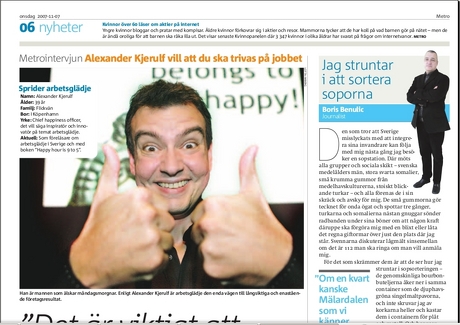 Over at the WorldBlu blog, Traci Fenton has another great post – this one on how we design our organizations.
Over at the WorldBlu blog, Traci Fenton has another great post – this one on how we design our organizations.
Traci does amazing work in creating democratic workplaces, and she increasingly sees companies introducing democracy in the workplaces:
…entrepreneurs and business leaders take note — you need to spend as much energy and time thinking about the design of your employee experience as you do about your next big idea.
When I talk about good workplace design I’m not talking about open floor plans in offices or traditional this-is-what-makes-a-great-place-to-work programs. I’m talking about designing an employee experience that engages people body and soul in meaningful interactions and meaningful work. The traditional design of business — call it command-and-control, authoritarian, hierarchal, etc. – can’t, by design, achieve this goal. But workplace democracy does, which is why I believe democratically designed organizations are future of work.
Democracy at work! I love it! If democracy is so great in society, then why are many businesses still run like third-world dictatorships?
But what is democracy at work? Here’s a quote from Traci’s recent op-ed article in the Christian Science Monitor:
What is a democratic workplace? It’s one that uses freedom rather than fear, peer-to-peer relationships rather than paternalism, engagement rather than estrangement. Beyond giving employees a vote, it’s about giving them a real voice in the decisions that impact their job and the organization.
This isn’t some keep-your-fingers-crossed-and-hope- they-make-the-right-choice way of working; it’s understanding that democracy is the way you tap the full creative potential of your employees to solve the problems you created your organization to fix. It’s understanding that the traditional hierarchical workplace structures that operated on disengagement and the delusion of control are now a recipe for defeat in today’s collaborative world.
Go check out WorldBlu some more and seriously consider whether your company should be on the WorldBlu list of democratic workplaces.
 I’m spending this week in Atlanta and Orlando studying how some major American Corporations do business – especially in regards to customer service.
I’m spending this week in Atlanta and Orlando studying how some major American Corporations do business – especially in regards to customer service.
 I recently visited the
I recently visited the  Two weeks ago I had a day that I was NOT looking forward to. I had two speaking gigs on a Saturday (which is great!) but they were in opposite ends of Denmark. I had to get up disgustingly early to make the drive to the first one and then there was barely enough time to finish that and drive 350 km to the next one. After that, it was another 300 km drive home.
Two weeks ago I had a day that I was NOT looking forward to. I had two speaking gigs on a Saturday (which is great!) but they were in opposite ends of Denmark. I had to get up disgustingly early to make the drive to the first one and then there was barely enough time to finish that and drive 350 km to the next one. After that, it was another 300 km drive home. I’m going to the US next week to meet with and study some American companies and their approach to customer service. You may know some of them… where was that list… Oh, yeah: There’s Coca-Cola, Delta, Capital Grill and some place called Disney or something like that… Ever heard of them?
I’m going to the US next week to meet with and study some American companies and their approach to customer service. You may know some of them… where was that list… Oh, yeah: There’s Coca-Cola, Delta, Capital Grill and some place called Disney or something like that… Ever heard of them? What does it take to make us happy at work? What’s one simple, easy, fun thing that we can all do – that works!
What does it take to make us happy at work? What’s one simple, easy, fun thing that we can all do – that works!

 Hey – guess who’s quoted in
Hey – guess who’s quoted in 